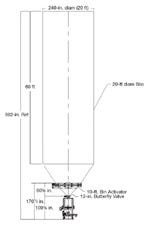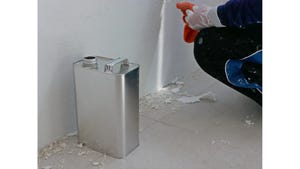Bin Activator Key to Efficient High-Rate Loss-in-Weight Feeding
April 2, 2008
|
Schematic drawing of a Vibra Screw 5-t/hr cement feed system |
One of the areas often overlooked in high-rate loss-in-weight feeding is reliable on-demand supply from the primary storage bin. Performance of the most sophisticated weigh-feeding systems often suffers from inattention to the large refill bin up above. This concern is especially critical with materials that are highly cohesive or tend to flush through the system when aerated.
At a South Carolina building-materials company, cement and kiln dust are stored in two 20-ft-diam silos and one 11-ft-diam silo. Both materials will alternately pack in the bin or fluidize beyond control. The company needed to precisely meter the kiln dust at 2 mtph and the cement at 5 mtph, so loss-in-weight feeding equipment was specified.
Designed by Vibra Screw, the loss-in-weight feeders consisted of a 50-cu-ft hopper with a small bin activator mounted above a 6-in. heavy-duty feeder. The bin/feeder assemblies are cell mounted and controlled by Model 2160 continuous loss-in-weight controllers.
The main storage silos were fitted with two 10-ft bin activators and one 7-ft bin activator, supplying the loss-in-weight systems through a refill valve.
In designing its weigh systems, Vibra Screw first designs an accurate volumetric system using simple robust mechanical components. In its volumetric configuration, the feed system performs at ±1–2% of set rate. When load cells and the loss-in-weight controller are added, accuracy increases to ±0.25–0.50%. With an accurate volumetric feeding capability as the starting point, calibration of the weighing system is easier, and error during refill is minimized.
The key to accurate feeding is delivering a steady stream of uniformly dense material on demand when refill is required. The bin activators on the primary storage silos perform this function. A bin activator replaces that portion of the bin transition cone where materials may bridge or pack. In addition to promoting flow, the bin activator deaerates material, bringing it to a uniform density.
The bin activator is suspended from the storage bin by forged steel hanger arms fitted with elastomer bushings. This provides great vertical strength while isolating almost all the vibration from the storage bin. A leakproof molded sleeve seals the gap between the bin activator and the bin, and an oil-lubricated and -cooled gyrator provides up to 9000 lb of vibratory force.
The body of the bin activator is formed from an ASME dished head for strength and maximum flow proportion. Working in conjunction with a steep lower cone, this dish/cone profile eliminates packing at the outlet. In addition, an internal baffle promotes flow from the upper reaches of the bin while also protecting the discharge outlet.
The loss-in-weight feeder systems are designed to operate 24 hours a day, seven days a week. When refill is required, the controller turns on the bin activators and opens their refill valves, recharging the feeder hoppers in a matter of seconds.
The customer now has a multiton storage and feeding capability free from bin-flow problems that will deliver the desired rate at ±0.25 to 0.50% accuracy.
For more information on Vibra Screw Inc., Totowa, NJ, call 973-256-7410, e-mail [email protected], or visit www.vibrascrewinc.com.
You May Also Like


